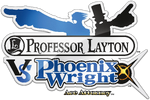| Turnabout Academy |
Image Gallery | Transcript |
| Aristotle Means |
| All right, class is now in session! |
Episode 3: Turnabout Academy is the third episode of the game Phoenix Wright: Ace Attorney: Dual Destinies. When a murder occurs at the Themis Legal Academy matching the one depicted in a mock trial, Juniper Woods, who set up the mock trial, finds herself as the defendant in a real one. Woods's friend Athena Cykes takes up her case, with Apollo Justice as co-counsel, against the mysterious convict prosecutor Simon Blackquill. Meanwhile, Woods is rumored to be involved in a love triangle between the cool and intelligent Hugh O’Conner and the hot-blooded Robin Newman, but Cykes senses that there is something else going on beneath the surface.
October 24
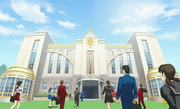
Themis Legal Academy.
- 1:25 p.m.
Months after Phoenix Wright's return to the courtroom, Themis Legal Academy asked him to give a seminar at the school festival. Wright invited Apollo Justice and Athena Cykes to come with him. However, Cykes arrived almost half an hour late.
- 1:29 p.m.
Cykes caught up with Wright in the hallway, where she met her childhood friend Juniper Woods, whom Athena had not seen for seven years. Woods appeared stiff and formal, in contrast to the shy and frail girl that Cykes remembered. Cykes also met one of the professors, Aristotle Means, who mentioned that Wright had been invited to observe the "mock trial", the highlight of the school festival meant for senior students. Wright was also supposed to meet with another professor, Constance Courte, but she had not shown up.
- 1:33 p.m.
Cykes met Justice in the Lecture Hall. Woods explained that the mock trial involved a representative from both the lawyer and prosecutor courses, who would debate over a selected script written by one of the seniors in the judge course, just like a real trial. Means added that the winner of the mock trial would be treated to a special seminar that would be held by either Wright or a well-known prosecutor who had also been invited to the school, depending on who won. Justice expressed interest in staying to watch, but Means said that the mock trial was reserved for students as it was part of the curriculum. An exception had been made for Wright. However, Wright graciously gave his seat to Justice so that he could learn something from the experience.
- 2:15 p.m.
Cykes and Wright waited outside in the hallway. Wright had hoped that Courte would show up, but she did not, so he began to take a nap. However, a loud crash was suddenly heard outside, prompting the two to investigate. The two arrived at an outdoor stage and discovered the dead body of Constance Courte.
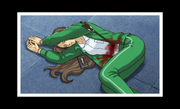
Professor Courte's body.
Cykes alerted the police and then made to inform the others, but Wright decided that they should investigate the scene before anybody else arrived. Courte was lying on the stage with an arrow through her stomach and ligature marks around her wrists. Her schedule book, bearing a sword motif, had fallen out of her shirt pocket. Due to the state of the body and the lack of blood around it on the stage, Cykes and Wright deduced that Courte had been killed sometime earlier and had been moved to the outdoor stage during the mock trial.
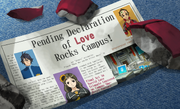
The malicious article from the school newspaper.
On either side of the stage were the remains of what seemed to be broken statues. Wright mentioned that the statues had been covered up when he and Justice had first arrived. Among the rubble of the statue on the left side was a copy of the school newspaper, the Themis Herald, which had a maliciously written article about an alleged love triangle between Woods and the two students who were facing each other in the mock trial. Suddenly, Justice ran up to them, telling them that the police had told the people in the Lecture Hall about the murder. When he saw the body, he was shocked; the state of the body was practically identical to the scenario from the mock trial!
The three lawyers returned to the Lecture Hall, and then Wright left to talk to Means about the crime. While they waited for more news, Justice and Cykes talked with Woods, as well as Robin Newman and Hugh O'Conner, the contestants in the mock trial. Cykes learned that Woods and Courte had prepared everything for the trial, including evidence and a base script, without anyone else knowing about the details. Woods was also going to sing in a concert for the festival, and she had made a star-patterned dress for the occasion. As for the mock trial itself, the police had arrived just before a verdict had been reached, though it seemed as if Newman was winning. It turned out that Woods, O'Conner and Newman had been friends ever since they enrolled, and they supposedly had some kind of symbol of their friendship. However, as they were talking about their friendship, Cykes detected discord in their voices.
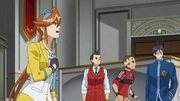
Cykes announces her intent to defend Woods.
Before Cykes could dwell on this, however, Bobby Fulbright arrived to arrest Woods. Fulbright did not give many details as to why Woods was being arrested, but he did say that Woods had led someone to the crime scene, and that the scenario in Woods's script matched the scenario for the real murder. As Fulbright took Woods away, Cykes declared that she was going to represent her in court. Newman and O'Conner made similar declarations before going off on their own.
Justice wondered how to explain the details of the mock trial when all of the props were gone, but Klavier Gavin stepped in. It turned out that he was the invited famous prosecutor, and was also planning on performing a song in the school festival concert. Gavin also said that he had studied at Themis, and although Courte was the judge course professor, she had had a profound impact on how Gavin thought about law, and he regretted not being able to reunite with her. Gavin suggested that they reprise the mock trial.
Mock trial reenactment
Cykes played the roles of the judge and the defendant, while Gavin took the role of prosecutor and Justice took the defense. Gavin opened the mock proceedings by describing the crime scene and the body. Courte had played as the victim, and the photo of the body had her wearing the same clothes and apparently shot with an arrow, just like the real murder. Justice pointed out that the absence of a pool of blood suggested a different crime scene. Gavin argued that the shape of the injuries ruled out the arrow as the murder weapon, and he argued that the real weapon was a blood-covered awl that had been left in the art room. Gavin noted that the defendant's fingerprints had been found on the awl, and that traces of the victim's blood had been found in the art room, suggesting that that was where the murder had occurred.
Cykes asked how the body could have been moved all the way from the third floor to the ground level. Gavin pointed out that there was a warehouse near the art room window, inside of which was a cart large enough to move a body, and a mat that could be used to drop the body without inflicting any blunt force trauma on it. A high school girl could easily have pulled all this off. The three decided to stop the mock trial here, before the defendant was declared guilty. Gavin wished them luck and left.
Cykes and Justice returned to the hall to find Wright and Means. Means expressed an intention to represent Woods, and use any means necessary to get her acquitted. Cykes informed him that she had already taken up her case, and she expressed concern for Means's approach to the case. Means told Cykes that if she valued justice for her clients above all else, then naturally she would have to use any means necessary to obtain that justice.
A legal academy corruped by the dark age of the law.
After Means left, Wright informed Cykes of what he knew about the case. The main concern was that a pool of blood had apparently been found in the art room, so the police were considering it the real crime scene, just like in the mock trial scenario. He also talked about the attitude that Means had displayed, which seemed to be emblematic of the state of the legal system these days. Prosecutors were filing false charges, and defense attorneys were fighting back by forging evidence. Wright then talked about that the rumors Themis Legal Academy was training its students to focus on results at the expense of fairness, because that was the only way to survive in this dark age of the law. However, Wright insisted that these were just rumors.
Interviews
Cykes and Justice returned to the outdoor stage and found Myriam Scuttlebutt snooping around. She said that she was taking the stand the next day, and she asked them for information. However, Justice's bracelet reacted and he noticed that Scuttlebutt would tighten her grip when she mentioned that she was gathering information for Woods's sake. Scuttlebutt denied that she was lying, but she said that she had been selected as a witness because she was the sole editor of the Themis Herald. Cykes replied that the paper that Scuttlebutt had just admitted to publishing revealed her true intentions. Scuttlebutt admitted to this and said that she had planted tape recorders all over the campus. She claimed that one of them in the art room had recorded the moment of the crime.
Cykes found O'Conner in the Lecture Hall. O'Conner told her that the three mock trial participants had been in a staff meeting room, waiting for the mock trial to start. However, O'Conner had stepped outside to meditate, and then he had seen the body on the stage while he was returning to the Lecture Hall. He had been so distraught that it impacted on his performance, but he had not told anyone about the body because then he would have missed his chance to "confess" to Woods.
Newman was in the maintenance area, allegedly working out. Cykes found out that Newman was in the Fine Arts Club and was responsible for making the stage statues. Moreover, Courte was the Fine Arts Club advisor. Newman also told Cykes about a vow that the three of them had made to conduct fair and honest trials to set an example for everyone else. However, this vow was in jeopardy because a conviction against Woods would disqualify her from graduating under school policy.
Before retiring for the day, Cykes visited Woods. Cykes learned that Woods had tried to revise the trial script to favor the prosecution upon seeing the article about O'Conner's planned confession, but Courte had noticed this and changed it back. Woods also said that the awl that she and Courte had prepared for the mock trial had not originally had blood on it, real or fake. However, when she had come to the art room to pick up the props for the trial, she had found the art room key and the awl covered in what looked like blood. She had thought nothing of it at the time, figuring that Courte had added the "blood" for realism. Cykes confirmed with Woods that the trial preparation the day before the mock trial was the last time that she had seen the victim.
Justice warned Cykes that the case so far was practically identical to the mock trial script. This meant that the real trial could go exactly the way the mock trial did. Cykes vowed that she would not let the real trial end in a guilty verdict.
Oct. 25
- 9:47 a.m.
Athena Cykes was nervous for her first trial as defense team leader. Phoenix Wright and Apollo Justice assured her that she would be fine, while Aristotle Means had a less favorable opinion. He asked her whether playing fairly was worth the risk of losing the trial, and he told her that she would learn the error of her ways soon enough.
Trial
- 10:00 a.m.
In court, Bobby Fulbright briefed everyone on the case. The awl was confirmed to have the victim's blood and the defendant's fingerprints on it. Moreover, Myriam Scuttlebutt's tape recorder had recorded a faint female voice saying, "You're a goner!" The mock trial participants were the only members of the school who had not been in the Lecture Hall during the mock trial. This meant that Juniper Woods was the only plausible suspect.
Myriam Scuttlebutt was called to the stand. She claimed that her script had been chosen in place of Woods's, and this had sparked her murderous rage. Cykes pressed Scuttlebutt's statements until the witness's claims were clearly established. The allegation was that the killer had intentionally aped the mock trial script, and that the similarities were not coincidental. However, Cykes pointed out that it would have been irrational for Woods to act in such a way that she was the only plausible culprit.
Scuttlebutt, however, testified that she had snuck into Woods's dressing room right before the mock trial. She had seen someone in Woods's concert stage costume, but when Scuttlebutt asked what she was doing, she had fled. Scuttlebutt had given chase until she discovered the body. Cykes pounced on this and pointed out that Scuttlebutt no longer had an alibi, but the witness replied that she had been in an "undercover reporter class" on the night of the murder.
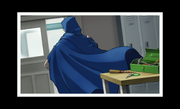
Scuttlebutt's photo of the costumed figure.
Blackquill moved to end the cross-examination if this kind of outburst was all that Cykes was going to make. However, Justice stepped in and pointed out that Scuttlebutt should have had a photo of the body, but she did not. Scuttlebutt had, however, caught a photo of the figure who had taken her to the body, albeit the face was hidden. Nonetheless, Justice had provided sufficient grounds to cross-examine the witness further.
After thanking Justice for the save, Cykes pointed out that the stage costume was supposed to have glowing stars on it, but the costume worn by the mysterious figure was plain blue. Since no other blue costumes existed, the natural conclusion was that the figure had worn the costume inside out, which Woods would not have done. At this, Blackquill submitted a photo of the costume in the dark. He explained that Woods had painted the inside with fluorescent paint and hung it inside-out on a mannequin to dry.

The Themis Herald article showing fluorescent paint on Newman's hand.
Justice noticed what looked like handprints in the photo and wondered what it meant. Cykes perused the court record and found her answer in the Themis Herald article. A photo showed Robin Newman's hand glowing in the dark while a spotlight was on Woods. Newman was called to the stand.
Newman claimed to have gone to see Woods in her dressing room. The mannequin had suddenly started falling and Newman had caught it, explaining the handprints. Cykes brought out her Mood Matrix for this testimony and noticed that Newman exhibited joy when talking about the costume. Newman seemed angered by the implications and said that the mannequin had fallen forward. However, the handprints consisted only of the thumbs and the base of the palms. This suggested that Newman had adjusted the costume while wearing it.
Newman admitted to wearing the costume, but Cykes noticed that Newman had felt not just excitement, but sadness as well. Newman replied that it was because the costume did not make the alleged manly hothead pretty like Woods. "Something" was getting in the way. Cykes noticed that Newman's anger was directed at the braces. Newman apparently wanted to take off the braces, but in some sense could not, because they were a symbol of masculinity. Cykes realized the monumental secret behind all of this behavior: Robin Newman was really a girl!
Newman removed her braces and admitted to being a girl. Cykes told the court that this changed the significance of the tape recording, as it implicated Newman just as much as it implicated Woods. Blackquill held his ground, pointing out that Woods was still the only one alive with access to the script. Cykes remembered her conversation with Woods the previous day, and suggested that Woods had leaked the script to Newman to ensure that she won the mock trial. To prove this, Cykes pointed out that the victim's outfit was supposed to be a red one from the prosecutor course. When the photo showed Courte wearing a green sweat suit, Newman had been thrown off, suggesting that she was privy to the script's details. The prosecution's assertion that the killer was someone who knew the contents of the script implicated Newman as well.
Newman countered that Courte had written a note to herself about various details of the case. Since there was only one copy of the script, Courte had a note written for convenience so she could prepare the props required, such as the crime scene photo. Newman had taken photographs of the note in question to gain an advantage in the mock trial. Nonetheless, it was the prosecution's argument that was in trouble here, since Woods was no longer the only one who could have been privy to the details of the mock trial.
In response, Blackquill called Hugh O'Conner to the stand, threatening him with some kind of secret to make him testify against Woods. O'Conner testified that he had seen Woods after a period of meditation, at 7:15. Blackquill explained that the recorder had recorded the female voice at 7:10. Cykes asked what he was doing on the day of the murder, and O'Conner replied that he had been meditating the whole day, and had not talked to anyone until the final bell at 7:00. However, Cykes presented Courte's planner, which indicated a meeting with O'Conner planned for that day. O'Conner pointed out that the recording was of a female voice, but Cykes asserted that the voice really belonged to Courte. Cykes claimed that the voice was really shouting O'Conner's full name, scolding him for something that he had done wrong.
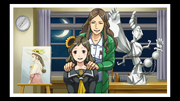
Woods with Professor Courte shortly before the murder.
Blackquill, however, still had one last piece of evidence to present. A photo of Courte and Woods together preparing for the mock trial showed a clock on the wall reading 7:05. Blackquill had had this evidence the whole time, even while Cykes was picking apart his other arguments. Justice wondered whether Blackquill had done this intentionally to demoralize Cykes. Regardless, the judge was about to give his verdict, and there was nothing that he or Cykes could do to stop it.
However, Newman suddenly confessed to the murder. While everybody scrambled to figure out what was going on, Woods also confessed, followed by O'Conner. It seemed that the three were willing to implicate themselves to save the others. The judge could not in good conscience hand down a verdict with this development. Cykes was as surprised as anyone else, but she was relieved to find that she would be given another day to sort out the case.
The deal
When Athena Cykes returned to the agency, she lamented the fact that the trial had spiraled out of her control. She returned to the detention center with Apollo Justice. When she got there, however, she learned that Juniper Woods had hired Aristotle Means as her attorney. Cykes nonetheless had some questions to ask her.
Cykes learned that the rumors surrounding the school had some basis in fact. A schism had developed between those who sought to find the truth and those who sought their favored results by any means necessary. Additionally, the photo presented by the prosecution had been taken around 6 p.m.; the time on the clock was wrong. Woods also said that she had seen Hugh O'Conner as she was leaving the art room, but she seemed upset by this fact. After encountering O'Conner, she had seen the two statues on the outdoor stage, though they were covered in sheets. Cykes thanked Woods for this information and had her promise that, if Cykes were able to find the truth of the case by sundown, then Woods would hire her as her attorney again.
Investigation
Cykes and Justice met Klavier Gavin on the outdoor stage. Gavin was lamenting the broken statues and the two missing banners. The three decided to gather the rubble on the stage and try to reassemble them. They managed to find the pieces of the statue of Gavin and a new white statue of Lady Justice. No evidence of the statue of Wright could be seen. There was also a wire-and-pulley system between the stage and the art room, where the school banner was. Bobby Fulbright was in the art room and lowered the banner for them. However, the Gavinners banner was still missing. Inside the school banner was what looked like a page from Constance Courte's journal, with "October Hugh 120" written on it. The banner itself had a bloodstain. Cykes also found drag marks behind the stage.

Scuttlebutt's first photograph.
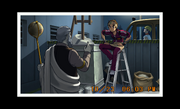
The second photograph.
Suddenly, a box sprang to life and ran away. Cykes and Justice chased it to the maintenance area. Myriam Scuttlebutt gave Cykes the burned remains of the Gavinners banner, which she had found in an incinerator. She was apparently so upset at being fooled by a scoop that wasn't there that she started deleting her photos. Cykes talked Scuttlebutt out of it, which managed to save only two photos. Cykes had by now figured out that Scuttlebutt secretly wanted to befriend the trio that she kept writing about. When Scuttlebutt accidentally broke her laptop, Cykes told her that she could borrow a laptop from the agency, on the condition that she would ask the trio to let her hang out with them. Scuttlebutt agreed to this and gave Cykes the two photos that she had remaining.
Cykes found O'Conner in the hallway. He refused to talk about the leverage that Simon Blackquill had over him or what the meeting with Courte was about, but he did point out that neither he nor Newman would have confessed if either of them were the real killer. He also stated that he would testify on the "truth" that Cykes so desperately wanted, but that it would not be favorable to her. He stated that he did not care about Woods anymore before leaving. Cykes and Justice decided to head for the art room.
The police had finished investigating the art room, and only Fulbright was there. He informed Cykes that the voice recording had been fully analyzed and Woods had been confirmed as the one shouting, "You're a goner!" Undeterred, Cykes checked the clock and confirmed that it was an hour ahead. Fulbright was not convinced that the clock had been wrong on the night of the murder, so Cykes pointed out that outside the window in the photo was what looked like a moonlit night sky, even though the moon would not have been visible from that window. She took one of Scuttlebutt's photos and showed that the night sky backdrop of the outdoor stage was being moved at 6 p.m., thereby forming the moonlit sky. Fulbright was forced to concede that the prosecution's argument on this matter had been refuted.
Cykes looked around for more clues. She found the winch that Fulbright had used to lower the school banner. A white rope on the floor indicated the location of a large bloodstain. Nearby was some of Newman's pottery, which also had bloodstains on it. Cykes also saw two paintings of Woods, a realistic one by Newman and a stranger style by Courte. In addition, Courte had apparently stored the mock trial scripts in a bookshelf in the art room, though Scuttlebutt's script was on a table next to an envelope marked "Use". Justice noticed that a white statue that was in Woods's art room photo was missing. Cykes asked Fulbright if he had seen Newman, and he replied that she was in the Lecture Hall.
Newman was indeed in the Lecture Hall, watching a video of the mock trial. She claimed that she had finished both statues on the night of the murder, but she could not produce any evidence of what she had been doing. There was apparently a snitch going around conducting surveillance on students, and there were rumors of bribes. Cykes asked Newman about the missing statue, and Newman replied that it had originally been a statue of Lady Justice, but Courte had broken it accidentally and then redesigned it. Cykes realized that this was the statue that she had put together earlier.

Woods setting up the audio during the mock trial.
Cykes watched the mock trial video with Newman. Before the mock trial, Means had given a speech. Newman said that Woods had been in charge of the audio in addition to her other duties. Newman also showed Cykes a diagram of the Lecture Hall, which showed that Means and Courte were supposed to be on balconies on either side of the Lecture Hall. The recording of the mock trial showed Woods yelling, "You're a goner!" Cykes realized that Scuttlebutt's recording had been fabricated using this voice clip. Gavin, who had just entered the Lecture Hall, asked for both recordings to analyze the voices in question. Justice then noted that it was almost sundown, and he and Cykes headed to the detention center to report their findings to Woods.
Woods heard Cykes's story, but she was still reluctant to cooperate with her. Woods insisted that neither Newman nor O'Conner would hurt a fly, and claimed that O'Conner was a gifted student who would never cause trouble. However, Justice noticed that she coughed when mentioning that O'Conner would never cause trouble. Cykes realized that O'Conner had figured out that Woods was the snitch, which was why he had claimed that he did not care about her anymore. Cykes pointed to Courte's planner, which mentioned a "routine report".
Woods admitted to being the snitch and suspecting O'Conner from the start. She said that she would report to Courte every month about any instances of wrongdoing that she had seen. Her reason for suspecting O'Conner was that she had overheard him talking to someone on the phone about paying money for good grades. Cykes realized that the scrap of paper that she had found was related to this, and she suspected that Courte was taking bribes. Woods then finally revealed that, during her encounter with O'Conner, she had seen his hand, and it had been dripping with blood! The cards were really beginning to stack against O'Conner now. Cykes assured Woods that she would get to the bottom of all this, whatever the truth may be.
Oct. 26
- 9:45 a.m.
Athena Cykes had hardly slept on the night before the trial, but she was ready. Klavier Gavin appeared with the audio analysis findings. The lab had found signs of overdubbing on the tape recording, and it was being analyzed further to extract the original recording. Apollo Justice suddenly noticed the presence of eavesdroppers. He and Gavin figured that Myriam Scuttlebutt, Robin Newman and Hugh O'Conner were spying on them, and Gavin promised to catch them before they could run away. Gavin wished the two defense lawyers luck for the trial.
Trial
- 10:00 a.m.
The trial began with O'Conner called as a witness, as expected. He testified to seeing Woods pulling the exercise mat from behind the stage before the mock trial. He claimed to have seen all this from a vantage point between the stage and maintenance area. Cykes countered that there was a construction screen beside the stage, which had been placed while the stage was being set up. The screen would have blocked O'Conner's view of the stage. In fact, the only way for O'Conner to see what Woods was allegedly doing was if he were near the back of the stage himself, where Woods would have seen him.
Blackquill then revealed O'Conner's secret: he was working part-time as a construction worker and he was operating a crane on the stage on the night of the murder. O'Conner would have been able to see Woods from inside the crane. One of Scuttlebutt's photos had captured the crane operator, who wore a band around his neck that appeared prominent enough to be identified. O'Conner reluctantly unzipped his school uniform collar, revealing the neck band. He admitted to being the crane operator. The judge pointed out that one had to be at least 20 years old to operate a crane. Against O'Conner's pleas, Blackquill dropped another bombshell: O'Conner was really 25 years old.
Cykes conjectured that O'Conner had used the crane to move the victim's body. However, O'Conner revealed his injured left hand, saying that the crane required two hands to operate, so he could not have used it at the time of the mock trial. As long as the prosecution's argument about the mat held, the defense had no case. With this in mind, Cykes posed an alternative theory: the body had been carried down the wire between the art room and the stage using the school banner.
Blackquill pointed out that the blood-splattered pottery in the art room was nowhere near the winch. Cykes asked whether that blood had been tested, and to Blackquill's surprise, it had not. The annoyed prosecutor called for a test, and the results showed that the blood belonged to O'Conner. Blackquill then revealed another of O'Conner's secrets: he had sustained his hand injury when he tried to peek at the script submitted by Scuttlebutt, which had been booby trapped with a spring-loaded razor.
Blackquill returned to Cykes's proposed theory, and he said that it was impossible because the banner would have knocked over the statues. Cykes asserted that that was exactly what had happened. Everybody realized that this meant that all this had to have taken place during the mock trial. Under intense pressure from both sides of the bench, O'Conner came clean about lying about seeing the body. Still, Blackquill noted that Woods was the only one at that time who could move around freely, since she was in charge of the audio. Far from being one of three possible suspects, she was now the only possible suspect.
Suddenly, O'Conner snapped and declared himself the real killer. He claimed that he had not taken part in the mock trial, but used a body double instead, allowing him to move freely around the school and move the body. As everyone began to question O'Conner's sanity, he pleaded with Cykes to cross-examine him with the Mood Matrix. Cykes took her only shot to stay in the game, and she found that O'Conner was inexplicably overloaded with happiness. She realized that, contrary to what O'Conner had told her yesterday, he really cared about Woods and was happy to lie to cover for her, to the point that it overshadowed all of his other emotions.
Blackquill jested that Cykes had merely revealed the obvious, but O'Conner insisted that Cykes try to disprove his body double claim. Cykes noticed that the feeling of happiness throughout O'Conner's testimony disappeared when he said that his body double was the one who had almost lost. O'Conner explained that he had slipped out during the pre-trial speech and returned to replace his body double just before the verdict, which was why he did not feel happiness when mentioning it. Only someone on the left balcony could have seen him, but he claimed that it was empty as Courte was already dead by then. Cykes pointed out that according to the lecture plan, this was Means's seat, not Courte's; O'Conner should have seen Means in his seat.
Cykes had O'Conner testify more about his escape. Cykes noticed powerful sadness and fear when he claimed that he had escaped through the empty audio control room. He knew that he had made a mistake with this claim, since it would once again throw suspicion onto Woods. This demonstrated even further that O'Conner was desperately trying to protect Woods.
O'Conner then admitted that he was not a genius. He had learned a few days prior that his parents had been bribing the teachers for his perfect scores. Woods had seen him while he was confronting his parents about the bribery. O'Conner had only given his damning testimony against Woods because he believed that it would somehow help her case.

Woods, Newman, and O'Conner.
O'Conner believed that he could never face Woods again because of the revelation that he was a fake. However, Cykes realized that his neckband was his proof of friendship. She had noticed that O'Conner would touch his neck when pressured. Similarly, Newman would touch her arm, and Woods would touch her wrist. Woods and Newman called out to him and revealed that they were still wearing their bands.
Realizing that their friendship had never been in doubt, O'Conner burst into tears and finally recanted almost his entire testimony. However, he maintained that Means's seat had been empty the whole time he was at the defense's bench. Means's speech must have been pre-recorded. O'Conner also revealed that the recording with Woods's voice on it had been given to him by Means, who asked him to hand it to the police. Cykes realized that Means's alibi was no longer solid and requested that Means testify.
As Means was summoned to the stand, the court went through the pre-trial speech, and Cykes noticed a contradiction. Means's speech referred to a "white Lady of Justice", but the statue in the lecture hall was gold. There was a white Lady Justice statue, but Courte had broken it. Means tried to brush this off as a mistake, but Cykes noticed something else. Means's speech lasted for 10 minutes and 35 seconds, which happened to be the same amount of white noise on the tape recording of Woods's voice. Cykes asserted that the original recording on the tape contained Means's pre-recorded speech.
Means admitted to pre-recording his speech, but he claimed that it had been part of a devious plan by Woods to evade suspicion on her. He claimed that Woods had asked him to make the pre-recorded speech and meet her in the audio room, and then she had threatened him into taking her case. Means testified that he had complied because he approved of her using any means necessary to achieve her ends, and because it was the humane thing to do. Cykes countered that Means had submitted evidence incriminating Woods to the police, which made no sense if he was really trying to defend her.

Professor Means drops his cheerful facade.
Means transformed into a harsher, stricter lecturer personality. He claimed that he had left school by the time of the murder, but Newman contradicted him, saying that he had offered to finish the Phoenix Wright statue for her. Means then testified that he had started working on the Wright statue at 7 p.m. and had finished by 8:30. He claimed that he had been so focused on the statue that he had not gone anywhere else. Cykes pressed him on this but, finding no concrete reason to doubt it, she conceded this point.
Cykes realized that the murder had actually occurred on the stage, and she presented the bloodstained school banner to prove it. Scuttlebutt's photo showed the Gavinners banner overlapping the school banner, and thus it had soaked up most of the blood. The killer had then brought the Gavinners banner to the art room via the wire and spread it over the floor, in order to fabricate the scene of the murder, and later burned the banner in the school incinerator, explaining the burnt fragments bearing the Gavinners logo that Scuttlebutt had found. Cykes identified the statue in Woods's photo as the white Lady Justice statue. She asserted that the killer had used the school banner and the wire to make the sculpture crash into the other two statues, in order to draw attention to the murder and establish his alibi.
However, Means had one final defense. No one had seen the body until Cykes had discovered it, so where had it gone until then? Means went further and declared that Cykes was not only failing Woods, but had almost gotten O'Conner convicted of the crime. Cykes froze and began to relive a past trauma, but Newman, O'Conner and Woods reminded her of all the good that she had done for them, rendering the false charges meaningless by comparison. Justice told Cykes that the truth would always triumph over people like Means, and Blackquill reminded her of someone that she was trying to save. Cykes thanked everyone and renewed her argumentative assault.
Cykes reviewed the case at hand and remembered that she had never found any fragments of the Wright statue. Means must have posed the body as the Wright statue. No one would have been the wiser because both statues had been covered with tarps. To prove this, Cykes proposed that she use her own body and a cloth to construct a facsimile of the concealed statue.
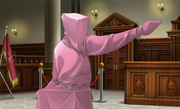
Cykes's re-enactment of the Wright statue.
Cykes had Justice tie her hands behind her head to mimic Wright's signature spiky hair. She then tried using an arrow to produce Wright's pointing arm, but it was too short. However, Means's staff, which turned out to be a spear, did the job; Scuttlebutt's photo proved that Means had his staff on hand during the time of the murder, meaning that he had the means to murder Courte on the stage. All they needed to do was test Means's staff for blood to prove that it was the murder weapon. Cornered, Means tried to bargain with the gallery, but he eventually fell in defeat.
Surely enough, blood was found on Means's staff, and Blackquill read out the disgraced teacher's confession. Means had murdered Courte after she confronted him over the bribes he was taking. He, like Newman, had learned of the mock trial script using the victim's notes. The notebook page with O'Conner's name on it had belonged to Means, who had a similar planner. The outcome of the trial left the judge surprised, but he nonetheless proceeded to declare Juniper Woods not guilty and wished her the best of luck of becoming a judge and helping to bring the dark age of the law to an end.
In the defendant lobby, Athena and Justice congratulated Juniper on her verdict, who thanked them in return and immediately began showing signs of admiration for Apollo. Phoenix and Trucy Wright appeared and said that, in memory of Constance Courte, the Themis Legal Academy school festival was being extended for one more day.
Oct. 27
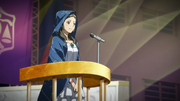
Woods on stage for her performance of "The Guitar's Serenade".
Juniper Woods joined Klavier Gavin and the Gavinners on stage for a performance of "The Guitar's Serenade". Woods then met Phoenix Wright, Athena Cykes, Apollo Justice, Robin Newman and Hugh O'Conner in the Lecture Hall. Newman declared that, although she had really wanted to be an artist rather than a prosecutor, Cykes had inspired her to go through with law school. Unbeknownst to Cykes, the mock trial had been redone, and O'Conner had won and had already finished his seminar with Wright. Cykes remembered that O'Conner was going to confess something to Juniper, but it turned out that he had planned to admit that he was not really a genius and that he was really 25 years old.
O'Conner asked Woods if they could be best friends again like before. Woods agreed and added that everyone - Newman, O'Conner, and even Myriam Scuttlebutt, who was hiding in a box nearby - would be needed to help return the courts to seeking only the truth. Justice remarked that the heartwarming scene reminded him of his best friend, and that he would be meeting him in the near future.
References to other cases
- The 1st floor hallway contains a poster advertising "Guilty Dogs" with a picture of a hot dog. This is a reference to Turnabout Reminiscence, where a 13 year-old Franziska von Karma, unimpressed by the slogan of the hot dogs sold from a vending machine in the District Court ("When you're in hot water, you might need a hot dog" - Winston Payne entry in a public contest to choose a slogan), came up with the arguably equally poor replacement: "If you leave matters in a Von Karma's hands, everyone in court will be found guilty dogs!"
- Juniper Woods's costume design for the festival concert is almost identical to that worn by Lamiroir in Turnabout Serenade. Neither Apollo Justice, Trucy Wright, nor Klavier Gavin make any comment on this, despite all three having met Lamiroir in said costume. Additionally, the song "The Guitar's Serenade" is the one that Gavin performs with Woods during the concert in said episode.
- If the academy newspaper is presented to Phoenix Wright, he mentions that he was an arts major at university. When Cykes asks how he became a lawyer instead, he responds that it was a very complicated situation, and she reads a lot of complex emotions from him. This is all in reference to the events of Turnabout Memories.
- The object of art hanging from the ceiling in the art room is actually Phony Phanty, a piece of evidence in Turnabout Countdown. Additionally, when lamenting that Woods' script was chosen over hers, Scuttlebutt says, "My script had it all! A bum rap and phony evidence!" This is likely a reference to Phony Phanty and Bum Rap Rhiny.
- Fulbright demanding prove that clock in the art room, which appears to be running slow, was running slow on the day of the murder, hearkens back to Frank Sahwit demanding the same thing in regards to the The Thinker, in The First Turnabout.
References to popular culture
- After investigating the body, Wright says to Cykes, "Nice work, Athena. Your face only turned five shades of pale. I was expecting fifty." This is a reference to the title of the novel Fifty Shades of Grey.
- If Justice fails to perceive Myriam Scuttlebutt's tell, Cykes will mention that Justice's ability is like a razor-sharp box cutter, to which he replies, "I'm a lawyer, not a superhero." This may be a reference to the "I'm a doctor, not a..." catchphrase often used by Dr. Leonard "Bones" McCoy in the science-fiction television series Star Trek: The Original Series, but also repeated with variations by other characters in the ensuing Star Trek franchise.
- When Cykes and Justice are talking to Scuttlebutt, Justice says, "Myriam, wouldn't you feel better if you came out of the dark and into the light?" This may be a reference to the Falco album Out of the Dark (Into the Light).
- There are numerous references to the Metal Gear video game series, in particular the cardboard boxes often used in the series as mobile disguises, which revolve around the cardboard box-wearing Myriam Scuttlebutt. The first is when Justice notices her box, and he says, "Don't let it be a SNAAAAAAAAAAAAAAAKE," which refers not only to the code name used by the main protagonist of the series, but also to the phrase used in the Game Over screen in many of the games ("Snake? Snake? SNAAAAAAAAAAAKE!") The final reference is after Woods's acquittal, when Cykes thinks to herself, "Myriam's got this Tactical Espionage Action stuff down to a science..." This is a reference to the "Tactical Espionage Action" tagline commonly used for the Metal Gear series.
- Newman calls Prosecutor Blackquill "Birdman" at one point during the first day of the trial due to his pet hawk, Taka. This may be a reference to the Adult Swim animated television comedy series Harvey Birdman, Attorney at Law, of which Capcom produced an Ace Attorney-style game.
- At the beginning of the second day of the trial, Cykes states that the "Cykes Brigade is psyched!" This may be a reference to the Haruhi Suzumiya franchise of visual novels and anime series, in which the titular character's club is named the SOS Brigade. Incidentally, Wendee Lee, the English voice actress for Athena Cykes, also voices Haruhi Suzumiya in the English dub of the anime adaptation.
- While Cykes is rebuilding the Lady Justice statue, Justice asks what is she doing, to which she replies, "Don't stop me now. The artist inside me wants to get out and have a good time." This is a reference to the first two lines ("Don't stop me now, I'm having such a good time") of the chorus of the rock song "Don't Stop Me Now" by the band Queen.
- As Cykes is questioning O'Conner about why he was running late, she at one point says to the judge, "Et tu, Your Honor...?!". This is a paraphrase of "Et tu, Brute?" These are the last words of the Roman dictator Julius Caesar in the eponymous play about him by William Shakespeare. Caesar says these words upon seeing that even his friend Marcus Brutus had joined those who had come to assassinate him.
- While discussing the statues of Phoenix Wright and Klavier Gavin that she had created, Newman states that she is thinking about rebuilding them, but this time by simply dropping the two men into a big bowl of plaster instead. When Cykes questions the safety of this idea, Newman exclaims, "Full on YOLO is what art's all about!", referencing the acronym of the saying, "You only live once."
- When asked about the "proof of friendship" in the beginning stages of the case, Newman is quoted as saying, "Proof?! We don't need no stinkin' proof!..." This is a reference to a well-known and widely (mis)quoted line that originally comes from the 1927 novel The Treasure of the Sierra Madre: "'All right,' Curtin shouted back. 'If you are the police, where are your badges? Let's see them.' 'Badges, to god-damned hell with badges! We have no badges. In fact, we don't need badges. I don't have to show you any stinking badges, you god-damned cabrón and chinga tu madre!' The film adaptation of the book says, "'If you're the police where are your badges?' 'Badges? We ain't got no badges. We don't need no badges! I don't have to show you any stinkin' badges!'"
- Before the start of the second trial day, Cykes says, "Okay, all that's left now is to reach out to the truth!" This may be a reference to the song "Reach Out To The Truth" from the game Persona 4.
- During the second trial day, examining Scuttlebutt in her box on the outdoor stage leads to Cykes commenting, "so this is the future cardboard box technology has afforded us, huh?". This could be a reference to the Level-5 franchise Little Battlers Experience (also known as 'Danball Senki'; lit. Cardboard War-chronicles). The franchise takes place in the near future, akin to Ace Attorney, and features the invention of super reinforced cardboard technology as part of it's backstory.
Notes
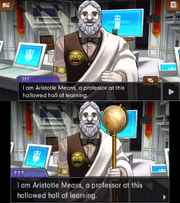
iOS (top) vs. 3DS (bottom)
- The fact that Woods was brought up on false charges in this episode becomes her purported motive for the bombing of Courtroom No. 4 in Turnabout Countdown.
- The "you-know-who" that Blackquill reminds Cykes that she must not let down is actually Blackquill himself, as revealed in Turnabout for Tomorrow.
- After his guitar catches fire in Turnabout Serenade, Klavier Gavin swears that he'll never play "The Guitar's Serenade" again. However, it would appear that he wasn't very serious about this promise, due to his playing of the song at the resolution of Turnabout Academy.
- In the Japanese version of Phoenix Wright: Ace Attorney: Dual Destinies, Means does not have his staff during the first encounter with him, before the mock trial, because it was stabbed into Courte's body at the time. This was changed for unclear reasons in the 3DS English version, which depicts him with the staff (thus creating a minor plot hole), but corrected in the iOS English version.
- Excluding a brief sequence in Farewell, My Turnabout wherein the player controls Maya Fey, Turnabout Academy is the only episode in the entire Ace Attorney series in which a female character is playable during an investigation.
Errors
- After the trial has been won, Newman says, "I think I'll stick with become a prosecutor after all." which should be becoming
- After the cutscene with Juniper on stage, Athena says, "Wow! That what SO much fun!"
- When Apollo is telling Athena not to lose hope against Means, he says "The truth will always wins against people like him."
Other languages
- Japanese - 逆転学園 (Gyakuten gakuen; lit. "Turnabout Academy")
- Korean - 역전 학원 (Yeogjeon Hag-won; lit. "Turnabout Academy")









